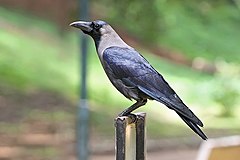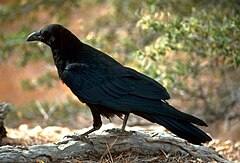Corvus
| Corvus[1] | |||
| Linnaeus, 1758[2] | |||
 Przedstawiciel rodzaju – wrona orientalna (C. splendens) | |||
| Systematyka | |||
| Domena | |||
|---|---|---|---|
| Królestwo | |||
| Typ | |||
| Podtyp | |||
| Gromada | |||
| Podgromada | |||
| Infragromada | |||
| Rząd | |||
| Podrząd | |||
| Rodzina | |||
| Rodzaj | Corvus | ||
| Typ nomenklatoryczny | |||
Corvus corax Linnaeus, 1758 | |||
| Synonimy | |||
| Gatunki | |||
| |||
Corvus – rodzaj ptaka z rodziny krukowatych (Corvidae).

Zasięg występowania
Rodzaj obejmuje gatunki występujące w Eurazji, Afryce, Ameryce Północnej (ze Środkową włącznie), Australii i Oceanii[6][7].
Morfologia
Długość ciała 34–69 cm; masa ciała 110–2000 g (samce są z reguły większe i cięższe od samic)[6].
Systematyka
Etymologia
- Corvus: łac. corvus „kruk”[8].
- Coloeus: gr. κολοιος koloios „kawka” (por. średniowiecznołac. koloyus „kawka”)[9]. Gatunek typowy: Corvus monedula Linnaeus, 1758.
- Amblycorax: gr. αμβλυς amblus „nudny, tępy”, od αμβλυνω amblunō „stępiać”; κοραξ korax, κορακος korakos „kruk”, od κρωζω krōzō „krakać”[10]. Gatunek typowy: Corvus violaceus Bonaparte, 1850.
- Anomalocorax: gr. ανωμαλος anōmalos „anomalny, dziwny”, od negatywnego przedrostka αν- an-; ομαλος omalos „równy”; κοραξ korax, κορακος korakos „kruk”, od κρωζω krōzō „krakać”[11]. Gatunek typowy: Corvus splendens Vieillot, 1817.
Podział systematyczny
Do rodzaju należą następujące gatunki[12]:
- Corvus dauuricus Pallas, 1776 – kawka srokata
- Corvus monedula Linnaeus, 1758 – kawka zwyczajna
- Corvus nasicus Temminck, 1826 – wrona kubańska
- Corvus jamaicensis J.F. Gmelin, 1788 – wrona jamajska
- Corvus leucognaphalus Daudin, 1800 – wrona antylska
- Corvus capensis M.H.C. Lichtenstein, 1823 – wrona przylądkowa
- Corvus ossifragus A. Wilson, 1812 – wrona rybożerna
- Corvus sinaloae L.I. Davis, 1958 – wrona lśniąca
- Corvus imparatus J.L. Peters, 1929 – wrona meksykańska
- Corvus palmarum Württemberg, 1835 – wrona haitańska
- Corvus minutus Gundlach, 1852 – wrona palmowa – takson wyodrębniony ostatnio z C. palmarum[13][14]
- Corvus hawaiiensis Peale, 1848 – wrona ogorzała
- Corvus frugilegus Linnaeus, 1758 – gawron
- Corvus crassirostris Rüppell, 1836 – kruk grubodzioby
- Corvus albicollis Latham, 1790 – kruk wielkodzioby
- Corvus corax Linnaeus, 1758 – kruk zwyczajny
- Corvus cryptoleucus Couch, 1854 – kruk meksykański
- Corvus ruficollis Lesson, 1831 – kruk pustynny
- Corvus edithae Lort Phillips, 1895 – kruk somalijski – takson wyodrębniony ostatnio z C. ruficollis[15][16][17]
- Corvus albus Statius Müller, 1776 – kruk srokaty
- Corvus rhipidurus E. Hartert, 1918 – kruk kusy
- Corvus brachyrhynchos C.L. Brehm, 1822 – wrona amerykańska
- Corvus corone Linnaeus, 1758 – wrona siwa
- Corvus pectoralis Gould, 1836 – wrona obrożna
- Corvus florensis Büttikofer, 1894 – wrona floreska
- Corvus typicus (Bonaparte, 1853) – wrona białoszyja
- Corvus unicolor (Rothschild & E. Hartert, 1900) – wrona jednobarwna
- Corvus enca (Horsfield, 1821) – wrona cienkodzioba
- Corvus compilator Richmond, 1903 – wrona sundajska
- Corvus validus Bonaparte, 1850 – wrona długodzioba
- Corvus moneduloides Lesson, 1831 – wrona brodata
- Corvus meeki Rothschild, 1904 – wrona melanezyjska – takson wyodrębniony ostatnio z C. woodfordi[18][19]
- Corvus woodfordi (Ogilvie-Grant, 1887) – wrona jasnodzioba
- Corvus violaceus Bonaparte, 1850 – wrona fioletowa – takson wyodrębniony ostatnio z C. enca[20][21][22]
- Corvus fuscicapillus G.R. Gray, 1859 – wrona brązowogłowa
- Corvus tristis Lesson & Garnot, 1827 – wrona szara
- Corvus insularis Heinroth, 1903 – wrona krzywodzioba – takson wyodrębniony ostatnio z C. orru[23][24]
- Corvus orru Bonaparte, 1850 – wrona papuaska
- Corvus bennetti North, 1901 – wrona mała
- Corvus mellori Mathews, 1912 – kruk mały
- Corvus tasmanicus Mathews, 1912 – kruk tasmański
- Corvus coronoides Vigors & Horsfield, 1827 – kruk australijski
- Corvus splendens Vieillot, 1817 – wrona orientalna
- Corvus macrorhynchos Wagler, 1827 – wrona wielkodzioba
- Corvus philippinus (Bonaparte, 1853) – wrona filipińska
- Corvus kubaryi Reichenow, 1885 – wrona mariańska
Przypisy
- ↑ Corvus, [w:] Integrated Taxonomic Information System [online] (ang.).
- ↑ C. Linnaeus: Systema naturae per regna tria naturae: secundum classes, ordines, genera, species, cum characteribus, differentiis, synonymis, locis. Wyd. 10. T. 1. Sztokholm: Impensis Direct. Laurentii Salvii, 1758, s. 105. (łac.).
- ↑ J.J. Kaup: Skizzirte Entwickelungs-Geschichte und natürliches System der europäischen Thierwelt: Erster Theil welcher die Vogelsäugethiere und Vögel nebst Andeutung der Entstehung der letzteren aus Amphibien enthält. Cz. 1. Darmstadt: In commission bei Carl Wilhelm Leske, 1829, s. 114. (niem.).
- ↑ Ch.L. Bonaparte. Notes sur les collections de M. A. Delattre. „Comptes rendus hebdomadaires des séances de l’Académie des sciences”. 37, s. 829 (przypis), 1853. (fr.).
- ↑ L. Fitzinger. Über das System und die Charakteristik der natürlichen Familien der Vögel. „Sitzungsberichte der Kaiserlichen Akademie der Wissenschaften. Mathematisch-Naturwissenschaftliche Classe”. 46 (1), s. 209, 1863. (niem.).
- ↑ a b D.W. Winkler, S.M. Billerman & I.J. Lovette: Crows, Jays, and Magpies (Corvidae), version 1.0. W: S.M. Billerman, B.K. Keeney, P.G. Rodewald & T.S. Schulenberg (red.): Birds of the World. Ithaca, NY: Cornell Lab of Ornithology, 2020. DOI: 10.2173/bow.corvid1.01. [dostęp 2020-08-15]. (ang.).

- ↑ F. Gill, D. Donsker & P. Rasmussen (red.): Crows, mudnesters, birds-of-paradise. IOC World Bird List (v10.2). [dostęp 2021-01-10]. (ang.).
- ↑ The Key to Scientific Names ↓, Corvus [dostęp 2022-02-05].
- ↑ The Key to Scientific Names ↓, Coloeus [dostęp 2022-02-05].
- ↑ The Key to Scientific Names ↓, Amblycorax [dostęp 2022-02-05].
- ↑ The Key to Scientific Names ↓, Anomalocorax [dostęp 2022-02-05].
- ↑ Systematyka i nazwy polskie za: P. Mielczarek & M. Kuziemko: Rodzina: Corvidae Leach, 1820 - krukowate - Crows and Jays (wersja: 2020-09-20). [w:] Kompletna lista ptaków świata [on-line]. Instytut Nauk o Środowisku Uniwersytetu Jagiellońskiego. [dostęp 2021-01-10].
- ↑ O.H. Garrido, G.B. Reynard & A. Kirkconnell. Is the Palm Crow, Corvus palmarum (Aves: Corvidae), a monotypic species?. „Ornitologia Neotropical”. 8, s. 15–21, 1997. (ang.).
- ↑ H. Raffaele, J. Wiley, O.H. Garrido, A. Keith, J.I. Raffaele & T. Pedersen: A Guide to the Birds of the West Indies. Princeton, NJ: Princeton University Press, 1998. ISBN 0-691-08736-9. (ang.).
- ↑ C.M.G. Blair. Hybridization of Corvus albus and Corvus edithae in Ethiopia. „Ibis”. 103a (4), s. 499–502, 1961. DOI: 10.1111/j.1474-919X.1961.tb02461.x. (ang.).
- ↑ C.H. Fry & S. Keith: The Birds of Africa. Cz. VI: Picathartes to Oxpeckers. Christopher Helm, 2000. ISBN 0-12-137306-1. (ang.).
- ↑ dos Anjos i in. 2009 ↓, s. 637.
- ↑ Ch.G. Sibley & B.L. Monroe Jr.: Distribution and Taxonomy of the Birds of the World. New Haven: Yale University Press, 1990. ISBN 0-300-04969-2.
- ↑ dos Anjos i in. 2009 ↓, s. 621.
- ↑ S. Madge & H. Burn: Crows and jays. Londyn: Princeton University Press, 1994. ISBN 0-691-08883-7. (ang.).
- ↑ F.E. Rheindt & R.O. Hutchinson. A photospot odyssey through the confused avian taxonomy of Seram and Buru (southern Moluccas). „Birding Asia”. 7, s. 18–38, 2007. (ang.).
- ↑ K.A. Jønsson, P.-H. Fabre & M. Irestedt. Brains, tools, innovation and biogeography in crows and ravens. „BMC Evolutionary Biology”. 12, s. 72, 2012. DOI: 10.1186/1471-2148-12-72. (ang.).
- ↑ G.C.L. Dutson, P. Gregory & W. Boles. Bismarck Crow Corvus (orru) insularis warrants species status. „Bulletin of the British Ornithologists’ Club”. 131 (3), s. 204–206, 2011. (ang.).
- ↑ dos Anjos i in. 2009 ↓, s. 622.
Bibliografia
- The Key to Scientific Names, J.A. Jobling (red.), [w:] Birds of the World [online], S.M. Billerman et al. (red.), Cornell Lab of Ornithology, Ithaca (ang.).
- L. dos Anjos, S. Debus, S. Madge & J. Marzluff: Family Corvidae (Crows). W: J. del Hoyo, A. Elliott & D.A. Christie: Handbook of the Birds of the World. Cz. 14: Bush-shrikes to Old World Sparrows. Barcelona: Lynx Edicions, 2009, s. 494–640. ISBN 978-84-96553-50-7. (ang.).
Media użyte na tej stronie
Autor: (of code) -xfi-, Licencja: CC BY-SA 3.0
The Wikispecies logo created by Zephram Stark based on a concept design by Jeremykemp.
Autor: Jakob Voß, influenced by original art designed at PLoS, modified by Wikipedia users Nina and Beao, Licencja: CC0
Closed Access logo, derived from PLoS Open Access logo. Alternative version.
Autor: Muhammad Mahdi Karim, Licencja: GFDL 1.2
House crow (Corvus splendens), Bangalore, India



